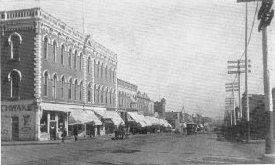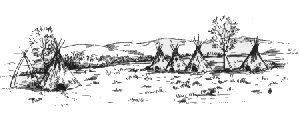 |
THE OLD TOWN
Where hills are fairest in splendor,
And brightest of skies look down,
Just at a bend of the River,
There lieth an Old Town.
 HERE are Old Towns and Old Towns, even in fair young Nebraska;—little burgs that the pioneers with unquestioning courage set along the great River in the days when few suspected that it was the Jordan of a promised land. Rather was it deemed a Nile to a Sahara. But the conquerors came and deployed along the stream with their faces to the west. If you ramble where they paused, be not surprised if you stumble unawares upon rotted boards or tumbling bricks in the grass. For some of the Old Towns did not survive. Their records are kept in the memories of pioneers or in yellowed documents and newspapers. Others of these frontier citadels had vitality enough to live, to thrive, and eventually to grow old gracefully, so that their names have become a charm, "known in sundry lands." The great army and the rear guard of conquest passed them by. The currents of Life left them almost as sandbars on the shores of Time. They seem content to stay where they have drifted and watch the world whirl by. A few have fallen not entirely out of the race. Yet like proud old dames, they ape not the fashions of the young folk, but sit and smile on their gayety, keep watch of the girth of their own oak-trees, and maintain sweetly that it is no misfortune to be old, when to be old is to be beautiful.
HERE are Old Towns and Old Towns, even in fair young Nebraska;—little burgs that the pioneers with unquestioning courage set along the great River in the days when few suspected that it was the Jordan of a promised land. Rather was it deemed a Nile to a Sahara. But the conquerors came and deployed along the stream with their faces to the west. If you ramble where they paused, be not surprised if you stumble unawares upon rotted boards or tumbling bricks in the grass. For some of the Old Towns did not survive. Their records are kept in the memories of pioneers or in yellowed documents and newspapers. Others of these frontier citadels had vitality enough to live, to thrive, and eventually to grow old gracefully, so that their names have become a charm, "known in sundry lands." The great army and the rear guard of conquest passed them by. The currents of Life left them almost as sandbars on the shores of Time. They seem content to stay where they have drifted and watch the world whirl by. A few have fallen not entirely out of the race. Yet like proud old dames, they ape not the fashions of the young folk, but sit and smile on their gayety, keep watch of the girth of their own oak-trees, and maintain sweetly that it is no misfortune to be old, when to be old is to be beautiful.
Nebraska City is known as perhaps the prettiest town in the state whose name it bears. It may be that the Old Settler has forgotten, and the stranger who wanders along the streets and beside the dun-colored water may not discover, the rare beauty and charm of the place. But come with me to a high aerie above the tree-tops, above the gray roofs and steeples, watch the Old Town as it basks peacefully in the softened sunshine among its venerable oaks, know it in its different moods and varying seasons. There will always be, then, though you may travel far and view the splendors of the earth, a little picture in your memory,—well worth keeping,—of a quiet, dreamy city, one-fourth house-roofs, and three-fourths tree-tops, set on gentle slopes, and with face to the Morning.
 |
But you will not see the glory of the Morning if you watch from your low earth dwellings. You must betake yourself to some high look-out. The temples of Phoebus are set on the hills. Behold! He comes up over the River, looking drowsy, and jaded and worn from his long, unrefreshed night journey. (You may doubt this, but indeed if you arise early, you will learn that it is very true). Then his glance falls upon the Old Town, and eagerly he quaffs the foamy bowl of mist brewed over night on the river and in the low vales between the hills, quaffs it as rich red wine. Soon his clouded face grows clearer; and the Old Town turns toward him, like a Nebraska sunflower, gathering brightness as it worships.
 |
Then too, if you walk low streets, you may think that the glory which rose beyond your neighbor’s house sets in the slough behind his barn. But it is really true, as you have read in poetry, that the Life-giver sinks to his rest far away among the hills. Often and often he wraps the Old Town in a wonderful cloud of red dust of gold ere he bids farewell. And seldom does he leave without rending the cloud-drifts for a last smile and caress. Golden Nebraska sunsets—to see one once is to wonder; to see them day after day is to feel that God is good.
 |
But the beauties of the Old Town are not reserved wholly for him who knows it from a bird’s point of view. As a city of trees it has charms for every wayfarer, especially for one who has erewhile sojourned on the treeless plains of the west. It is hard to credit the Old Settler who tells you that these great oaks and elms, these spreading maples and stately walnuts were planted by the pioneers. One would think rather that Nature had the hills all in readiness for the coming of the Paleface, that his home might grow up under the trees, not the trees around his home. Yet the Builders so wisely supplemented Nature that the Old Town has long been a beacon in a wilderness, How pathetic, in
 reality, is the thought of the little fellow, born among the sand-hills, who told his Sunday school teacher that Moses must have lived on a treeclaim, or he would never have seen a burning bush.
reality, is the thought of the little fellow, born among the sand-hills, who told his Sunday school teacher that Moses must have lived on a treeclaim, or he would never have seen a burning bush.
The Old Town is only a tree-claim grown venerable.
The sight of the great mass  of green leaves and broad trunks would be a holy feast to the hungry ones of the sand-hills. But it must also be a delight to every lover of nature, and every artist. The grouping and coloring seem unsurpassable, and often a camera will secure a picture worthy to hang in the salon. There are broad, level avenues where trees separate just enough overhead to show a crescent of blue sky; great landmarks on corners, that you come to know as a friendly greeting when you pass by them; and on one side street you will surely notice a sturdy old Middle-of-the-Roader, who stands, a lesson in independence, to every passer-by. The trees recognize no caste among men, for the mightiest oak may shelter the humblest hut; and cottage and mansion alike has each a group of noble friends.
of green leaves and broad trunks would be a holy feast to the hungry ones of the sand-hills. But it must also be a delight to every lover of nature, and every artist. The grouping and coloring seem unsurpassable, and often a camera will secure a picture worthy to hang in the salon. There are broad, level avenues where trees separate just enough overhead to show a crescent of blue sky; great landmarks on corners, that you come to know as a friendly greeting when you pass by them; and on one side street you will surely notice a sturdy old Middle-of-the-Roader, who stands, a lesson in independence, to every passer-by. The trees recognize no caste among men, for the mightiest oak may shelter the humblest hut; and cottage and mansion alike has each a group of noble friends.
 |
But the Spirit of Progress has already committed well-nigh unforgivable sins even here in a land of romance. It has mocked at ancient relics and broken to fragments the hieroglyphics of the past. Strange anomaly! The Old Town has a clear, mathematical, India-rubber street nomenclature, which might be the envy of all uninspired Moses striving to lead other cities out of a wilderness of errors and alphabets. The poetic names of a race that may itself become only a name in history, were fittingly bestowed by the Builders. But Kiowa, Nemaha, Pawnee, Otoe, and the rest, were thrust out of their tepees to make room for the Idea of the Paleface. We have no time for romance, say you? We are too busy with our mills and shops, our stores and offices, our schools and churches and societies? We are proud of our industries and success, and are in as much of a hurry as the rest of the world?
 |
It may be, and it may be well if it is so. But to those who gaze day after day from a high look-out above the Old Town, it is a place of visions, a quiet, dreamy city, one-fourth house roofs and three fourths tree-tops, clinging to the hills just at a bend of the River.

Highways and Byways
Return to Legacy
© 2001, Lynn Waterman